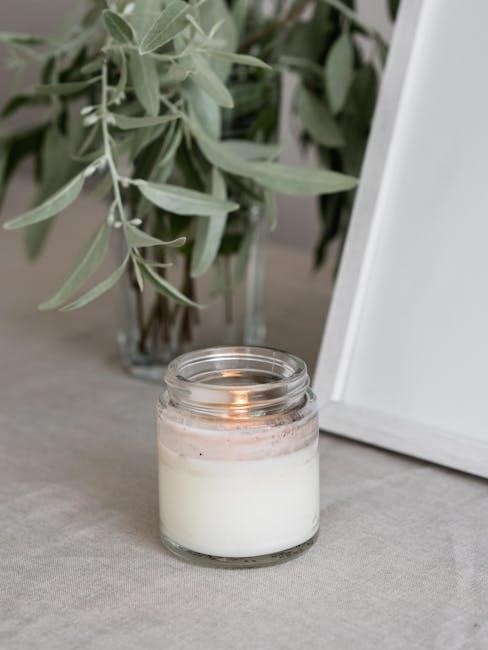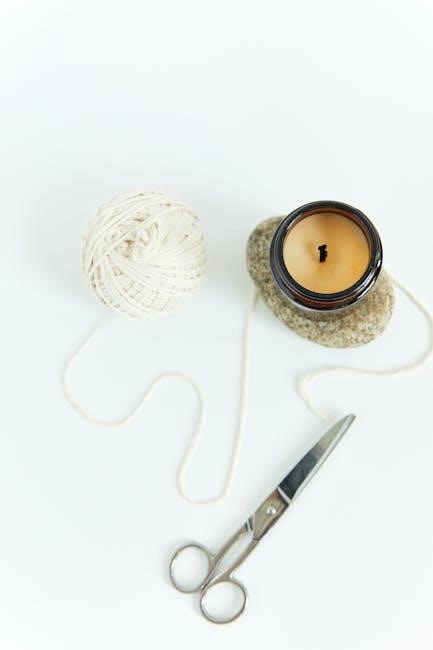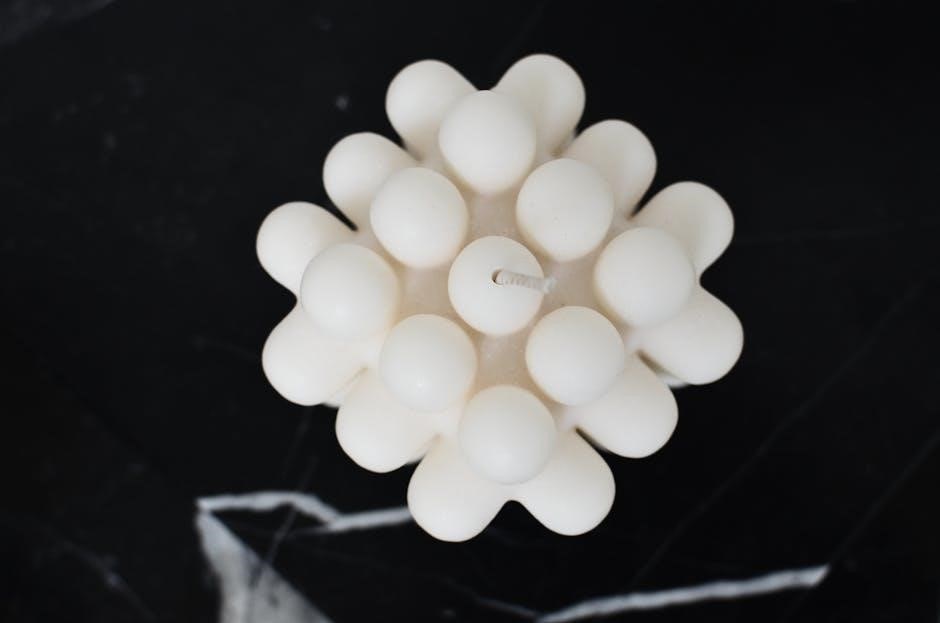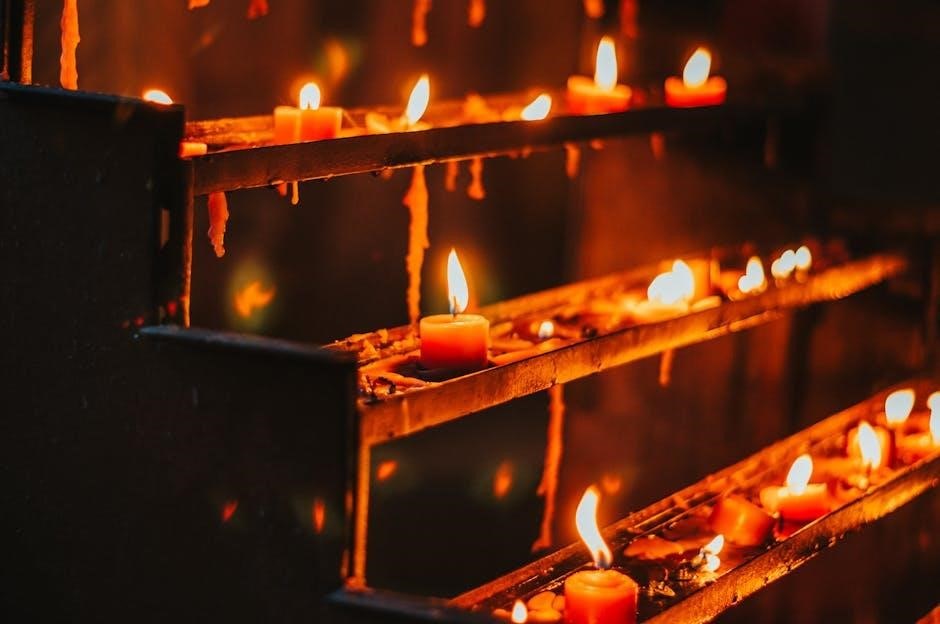candle wick guide
Candle wicks are essential components in candle-making, playing a crucial role in ensuring even burning, stability, and a consistent flame. Their size, shape, and material significantly impact a candle’s performance, making wick selection vital for optimal results. Understanding wick dynamics is key to crafting high-quality candles that provide a safe and enjoyable experience. This guide offers insights into selecting, testing, and maintaining the perfect wick for your needs.
What Is a Candle Wick?
A candle wick is a cord-like structure placed at the center of a candle, designed to ensure controlled combustion. When lit, the wick draws fuel (typically wax) to the flame, maintaining a steady burn. The wick’s material and size significantly influence the candle’s performance, affecting flame size, burn rate, and overall stability. Properly selected wicks are essential for even melting and consistent light output, making them a fundamental element in candle-making. The wick’s role is crucial for both functionality and safety, ensuring a reliable and enjoyable experience when using candles.
Importance of the Wick in Candle-Making
The wick is a critical component in candle-making, directly influencing the candle’s performance, safety, and overall quality. A properly selected wick ensures a steady, even burn, preventing issues like tunneling or an overly large flame. It regulates the flow of wax to the flame, maintaining consistent light output and burn rate. A well-chosen wick minimizes soot formation and promotes a clean, efficient combustion process. Its size and material are vital for optimizing the candle’s burn time and stability, making the wick essential for achieving the desired aesthetic and functional experience in any candle. A poor wick choice can lead to suboptimal performance and safety hazards.
History and Evolution of Candle Wicks
Candle wicks have evolved from ancient reeds to modern, precision-crafted materials, with advancements in technology improving burn consistency, safety, and efficiency over centuries.
Origins of Candle Wicks
The origins of candle wicks trace back to ancient civilizations, where early humans used reeds or rushes dipped in animal fat for primitive lighting. Egyptians and Romans later employed linen strips soaked in tallow, marking the beginning of wick evolution. These early wicks were rudimentary, often producing uneven flames and excessive smoke. The development of candles for both practical and ceremonial purposes drove the need for more reliable wicks, setting the stage for advancements in materials and design. This historical foundation laid the groundwork for the sophisticated wicks used in modern candle-making.
Development Over Time
Over centuries, candle wicks evolved significantly, adapting to advances in materials and understanding of combustion. Early wicks were simple, often made from twisted paper or cotton, but improvements came with the introduction of braided and cored wicks. The shift from tallow to spermaceti and paraffin wax enabled more consistent burning, prompting wick designs to optimize these fuels. Modern wicks now incorporate diverse materials, such as paper, metal, and synthetic fibers, tailored for specific candle types and fragrances. These advancements ensure cleaner, safer, and more efficient burning, reflecting a blend of tradition and innovation in candle-making.

Types of Candle Wicks
Candle wicks come in various types, including cored, lead-core, paper, and flat braided wicks. Specialty wicks like wood and multiple wicks offer unique burning characteristics and aesthetic appeal.
Materials Used for Candle Wicks
Candle wicks are crafted from various materials, including cotton, paper, and specialized synthetic blends. Cotton remains the most traditional choice, offering a steady burn and compatibility with soy or beeswax. Paper wicks are eco-friendly and often used in container candles for a smooth, consistent flame. Synthetic fibers, like polyester, enhance durability and are ideal for tealights or votives. Each material is selected based on the candle type, wax used, and desired burn characteristics. The choice of material significantly impacts performance, ensuring a clean, even burn and minimal soot production. Proper material selection is crucial for safety and efficiency in candle-making.
Shapes and Sizes of Wicks
Candle wicks come in a variety of shapes and sizes, each designed for specific candle types and performance needs. Common wick shapes include straight, curved, and flat, with straight wicks being the most common for container candles. Sizes range from thin, delicate wicks for tealights to thicker options for large pillar candles. The wick’s diameter and length are critical, as they affect burn rate, melt pool size, and flame stability. Proper sizing ensures even burning, prevents overheating, and minimizes soot. Tabbed wicks, with a metal base, are popular for container candles, while flat braided wicks are ideal for pillar candles. Testing different sizes and shapes is essential to achieve the perfect burn for your candle.
Selecting the Right Wick
Selecting the right wick is crucial for optimal candle performance. Consider factors like wax type, fragrance load, container size, and desired burn characteristics to ensure proper flame stability and even burning, achieving a clean, consistent experience.
Factors to Consider When Choosing a Wick
When selecting a candle wick, several factors must be considered to ensure optimal performance. The type of wax used is crucial, as different waxes have varying melting points and viscosity levels. Fragrance load is another key factor; higher fragrance concentrations require a larger wick to maintain a steady burn. The size and shape of the candle container also play a significant role, as they influence airflow and heat distribution. Additionally, the desired burn rate and the candle’s intended use, such as for ambiance or scent throw, will guide your wick choice. Proper wick selection ensures a clean, consistent burn and enhances the overall candle experience.
Step-by-Step Guide to Selecting the Perfect Wick
Selecting the right wick involves a systematic approach to ensure optimal candle performance. First, determine the type of candle you’re making, as container, pillar, or specialty candles require different wick sizes. Next, consider the wax type, as soy, beeswax, or paraffin each have unique viscosity levels. Assess the fragrance load, as higher concentrations demand larger wicks. Measure the candle’s diameter and height to guide wick length and width choices. Test the wick by conducting a burn test to observe the melt pool and flame stability. Finally, adjust the wick size based on test results to achieve a clean, even burn. This process ensures a perfectly balanced candle.

Testing Your Candle Wick
Testing ensures the wick burns evenly, with a stable flame and proper melt pool. Conduct burn tests to evaluate flame consistency and overall performance for safety and efficiency.
How to Conduct a Burn Test
To conduct a burn test, light the candle in a draft-free area and observe the flame’s behavior. Ensure the first burn is the longest to establish a proper melt pool. Monitor the wick’s performance, noting if it burns evenly, produces excessive soot, or causes the flame to flicker. Measure the melt pool diameter to ensure it reaches the jar’s edges without overheating. Record the burn time and observe the wax consumption rate. Adjust the wick size or type based on the results to achieve a clean, consistent burn. This process helps identify issues like wick size, fragrance load, or wax type incompatibilities, ensuring a safer and more efficient candle. Regular testing optimizes candle performance and safety.
Troubleshooting Common Wick Issues
Common wick issues often stem from improper sizing, fragrance overload, or burn practices. A too-large wick may cause excessive soot or heat, while a too-small wick can result in a weak flame or incomplete melt pool. Sooting can occur due to poor wax-wick compatibility. To address these, start by adjusting the wick size—experimenting until the flame is clean and even. Ensure fragrance levels are within recommended limits to prevent overwhelming the wick. Additionally, maintain consistent burns by allowing the melt pool to reach the jar’s edges, preventing tunneling. Regularly inspect the wick for signs of mushrooming or drowning, replacing it if necessary. By systematically addressing each issue through size adjustments, fragrance control, and proper burn maintenance, you can optimize candle performance and safety.

Maintaining Your Candle Wick
Regular wick maintenance is crucial for optimal candle performance. Always trim the wick to the recommended length before each use to prevent mushrooming and ensure a clean burn.
How to Trim and Care for Your Wick
Proper trimming and care of your candle wick are essential for a safe and even burn. Always trim the wick to 1/4 inch before lighting to prevent excessive flame height and soot buildup. Use scissors or a wick trimmer for a clean cut. Avoid touching the wick with bare hands, as oils from your skin can cause uneven burning. After each use, allow the wax to cool and harden before relighting. Regularly inspect the wick for signs of wear, such as fraying or discoloration, and replace it if necessary. Proper care ensures a consistent, enjoyable burning experience.

Applications of Different Wick Types
Different wick types are tailored for specific candle-making applications, ensuring optimal performance in container, pillar, or specialty candles. Each wick material and size suits unique wax blends, fragrance loads, and desired burn characteristics, making them ideal for various candle designs and purposes.
Wicks for Container Candles
Container candles require wicks tailored to their specific needs, ensuring a stable, consistent burn. The wick size and material must match the candle’s diameter, wax type, and fragrance load to avoid tunneling or uneven melting. Cotton, paper, or synthetic-blend wicks are commonly used, with flat braided or cored wicks being popular choices for their reliability. Proper wick sizing ensures a full melt pool, preventing excess wax buildup. For scented container candles, a slightly larger wick may be needed to handle fragrance oils effectively. Specialty wicks, like those withbuilt-in stabilizers, can reduce soot and improve burn quality. Selecting the right wick ensures a clean, even burn and enhances the candle’s overall performance and safety.
Wicks for Pillar Candles
Wicks for pillar candles are chosen based on the candle’s height, diameter, and wax type to ensure a stable, consistent burn. Flat braid or square braid wicks are often preferred for pillar candles, as they provide a steady flame and even wax consumption. The wick size must be carefully selected to achieve a full melt pool without causing the wax to become too soft or runny. Proper wick support and centering are crucial to prevent the wick from leaning or the candle from becoming misshapen. A well-selected wick ensures a clean, even burn and enhances the safety and aesthetic appeal of pillar candles, making them ideal for decorative and ambient lighting purposes.
Specialty Candles and Their Wicks
Specialty candles, such as those made from soy, beeswax, or gel, require carefully selected wicks to ensure proper burning. These candles often feature unique fragrances, colors, or layered designs, which demand specific wick types. For instance, soy candles may use flat braid or paper-core wicks to handle their softer wax and higher fragrance loads. Similarly, gel candles often require a wick with a stable, consistent burn rate to prevent uneven melting. Cored wicks are ideal for container candles, while square or flat braid wicks work well for pillar styles. Testing is crucial to ensure the wick performs optimally, maintaining a clean, even burn without excess soot. Proper wick selection enhances the candle’s aesthetic and functional appeal, making it a key factor in crafting distinctive, high-quality specialty candles.
Safety Tips for Candle Wicks
Always trim wicks to 1/4 inch before burning to prevent excessive flame height. Keep candles away from drafts and flammable materials. Never leave burning candles unattended.
Safe Burning Practices
Safe burning practices ensure candles are used responsibly, minimizing fire risks. Always place candles on stable, heat-resistant surfaces, away from flammable materials like curtains or bedding. Trim wicks to 1/4 inch before each use to maintain a controlled flame. Avoid burning candles near open windows or doors, as drafts can cause uneven burning or accidental extinguishing. Never leave a burning candle unattended, especially around children or pets. Keep the candle away from any sources of heat or sparks. Extinguish the flame if it becomes too high or flickers violently, as this may indicate improper wick size or environmental interference. Always follow the manufacturer’s guidelines for burn time and wick maintenance to ensure a safe and enjoyable experience. By adhering to these practices, you can maximize safety while enjoying the ambiance of your candle. Regularly inspect the candle for signs of wear, such as cracks in the container or excessive soot buildup, which may require immediate attention. Proper care and attention to these details will help prevent potential hazards and ensure a pleasant, risk-free environment for candle use. Additionally, being mindful of the surrounding environment, such as the proximity to combustible materials and ensuring good ventilation, further enhances safety. Remember, a well-maintained candle not only burns more efficiently but also contributes to a safer home setting. Always prioritize caution when handling fire, as it can be unpredictable and dangerous if not managed properly. By following these simple yet crucial steps, you can enjoy the beauty and warmth of candles with peace of mind. Furthermore, staying informed about candle care and safety standards helps in making better decisions for maintaining a safe and cozy atmosphere. Never underestimate the importance of proper candle maintenance, as it directly impacts both performance and safety. Always be vigilant and proactive in ensuring that every precaution is taken to prevent accidents. After all, a safe candle is not just about the wick, but also about how it’s used and cared for. So, take the time to understand and implement these safe burning practices to fully appreciate the benefits of candlelight without any risks. This mindful approach will enhance your overall experience and ensure that every moment with a candle is both enjoyable and secure.
Environmental Considerations
Eco-friendly wick options, like paper or bamboo, reduce environmental impact. Sustainable materials and responsible sourcing promote greener candle production, aligning with eco-conscious values and practices.
Eco-Friendly Wick Options
Eco-friendly wick options, such as bamboo, paper, or hemp, are gaining popularity due to their sustainability and reduced environmental impact. These materials are biodegradable and non-toxic, making them ideal for environmentally conscious consumers. Bamboo wicks, for instance, are sourced from rapidly renewable resources and produce minimal soot, ensuring cleaner burning. Paper wicks are another sustainable choice, often used in container candles for a smooth, consistent flame. Hemp wicks are naturally resistant to mold and mildew, offering a durable and eco-conscious alternative. By choosing these options, candle makers can align with green practices, appealing to those who prioritize environmental sustainability. Eco-friendly wicks not only benefit the planet but also enhance the candle’s performance and aesthetic appeal.
Understanding candle wicks is crucial for optimal candle performance and safety. Proper wick selection enhances burn quality, ensuring a enjoyable and hazard-free experience. Explore further to master candle crafting!
Candle wicks are fundamental to a candle’s performance, safety, and aesthetic appeal. The wick’s material, size, and shape must align with the candle type and fragrance load. Proper wick selection ensures a clean, even burn, while incorrect choices can lead to issues like soot or an unstable flame. Regular maintenance, such as trimming, is essential for optimal burning. Environmental considerations and safety practices further enhance the candle experience. By understanding these elements, candle makers can craft high-quality, reliable products. Mastery of wick selection and care requires experimentation and adherence to best practices, ensuring a satisfying and safe candle-burning experience for all users.
Encouragement for Further Exploration
Exploring the world of candle wicks is a rewarding journey that combines creativity, science, and practicality. By mastering wick selection, testing, and maintenance, you can elevate your candle-making skills and create safer, more enjoyable products. Experiment with different materials and techniques to discover what works best for your unique needs. Dive deeper into eco-friendly options and innovative designs to stay ahead in the craft. Engage with candle-making communities and forums to share ideas and learn from others. Remember, the art of candle crafting is limitless, and every experiment brings you closer to perfection. Embrace the process and enjoy the journey of creating something truly special.
Resources for Further Learning
Explore books, online tutorials, and candle-making communities for in-depth guidance on selecting and testing wicks. Visit reputable websites like CandleScience and The Spruce Crafts for expert advice and tips.
Recommended Reading and Websites
For further learning, explore CandleScience and The Spruce Crafts, which offer comprehensive guides on candle-making and wick selection. Check out “The Candle Maker’s Companion” by Betty Oppenheimer for detailed insights. Websites like CandleMaking.com provide tutorials and troubleshooting tips. Visit National Candle Association for industry standards and safety guidelines. Additionally, YouTube channels such as “Candle Making with [Expert Name]” share practical video tutorials. Books like “Handmade Candles: A DIY Guide” by [Author Name] cover wick basics and advanced techniques. These resources will help you refine your skills and stay updated on the latest trends in candle crafting.
